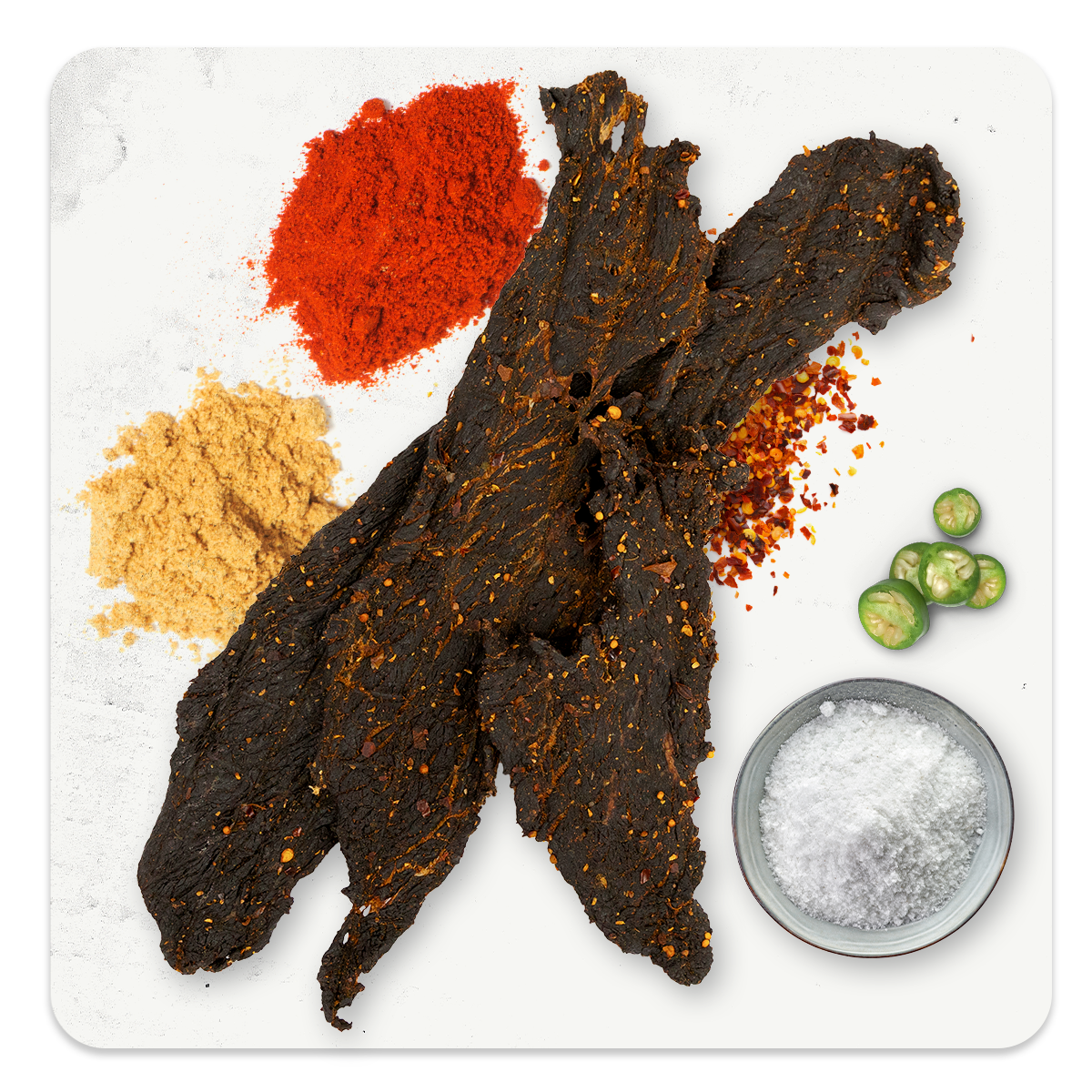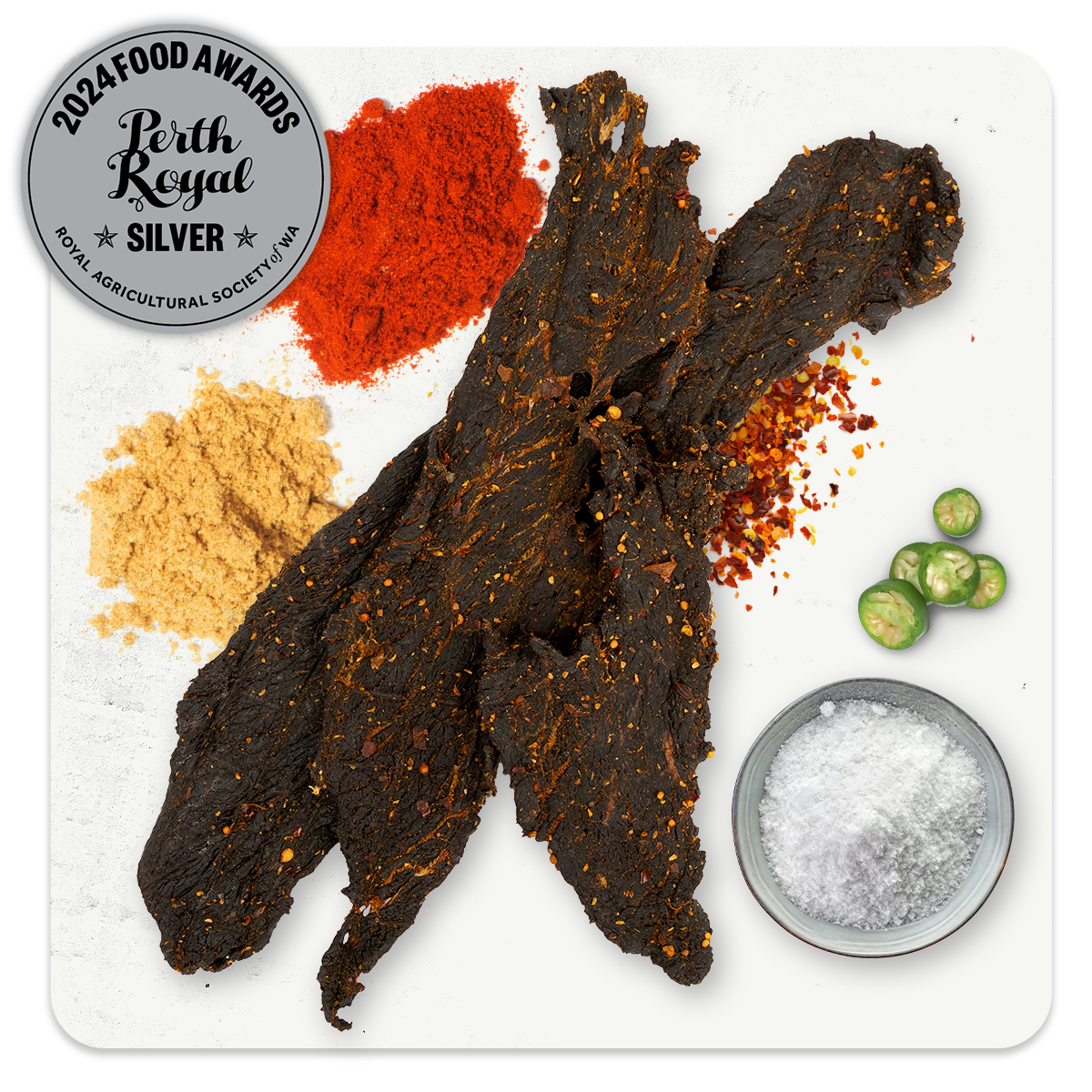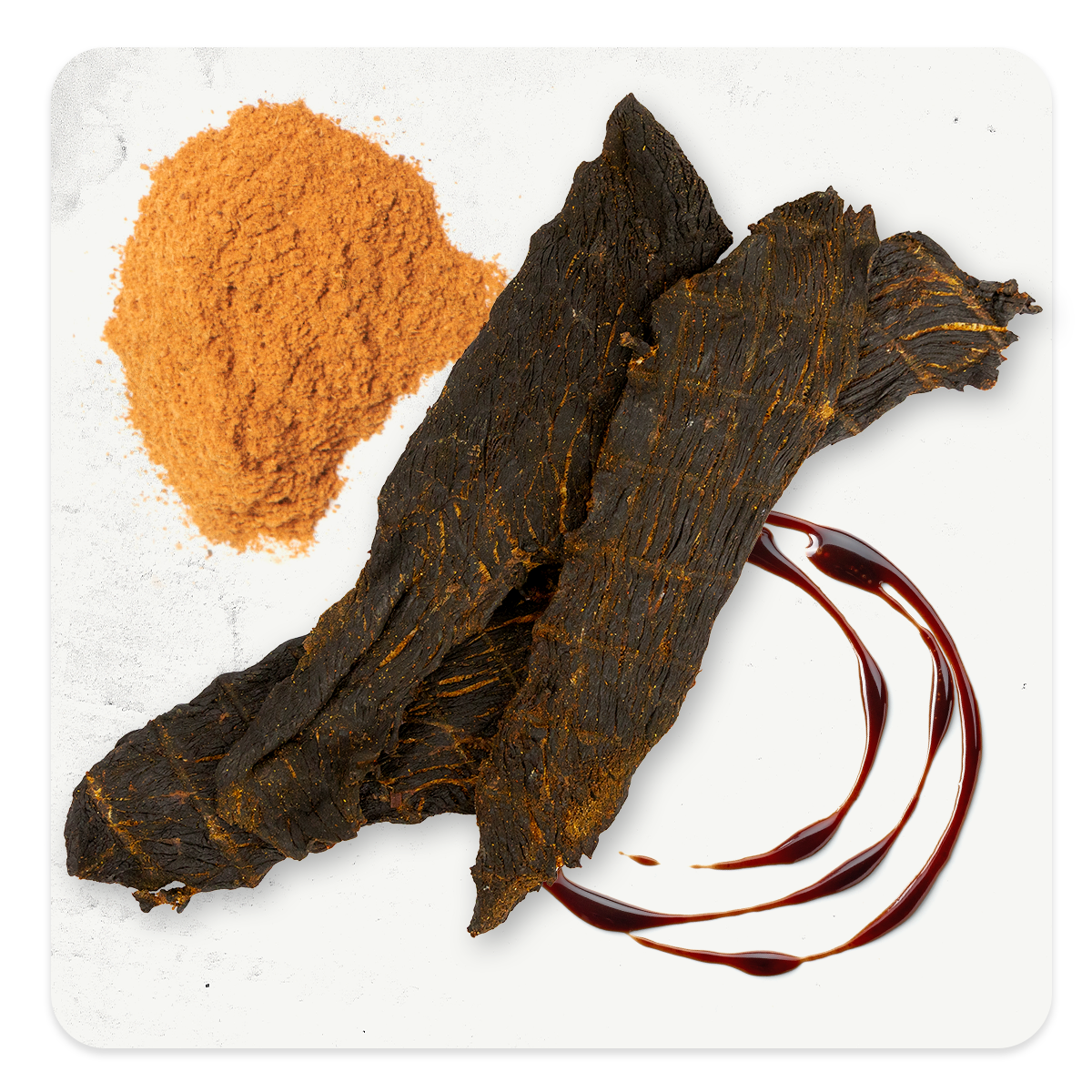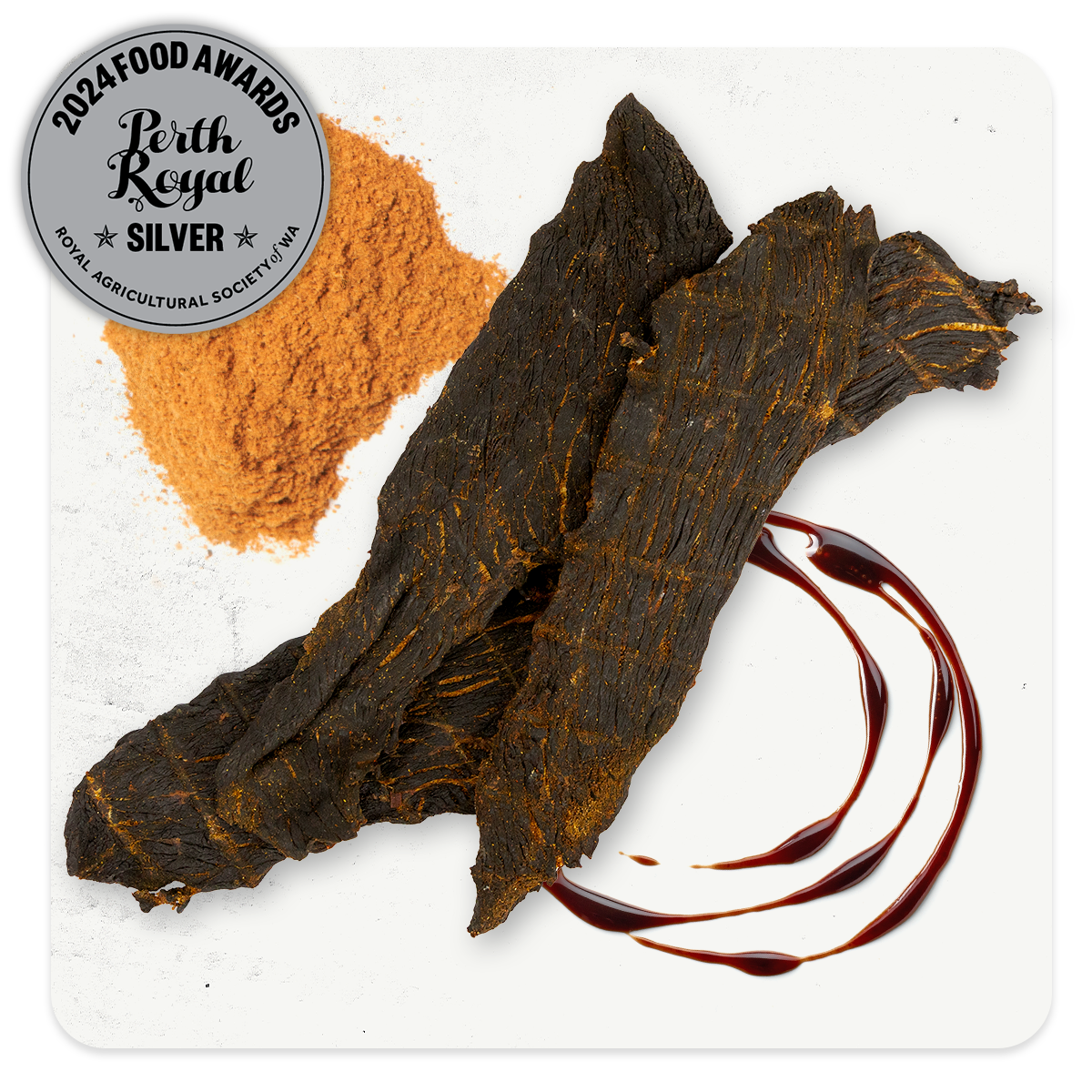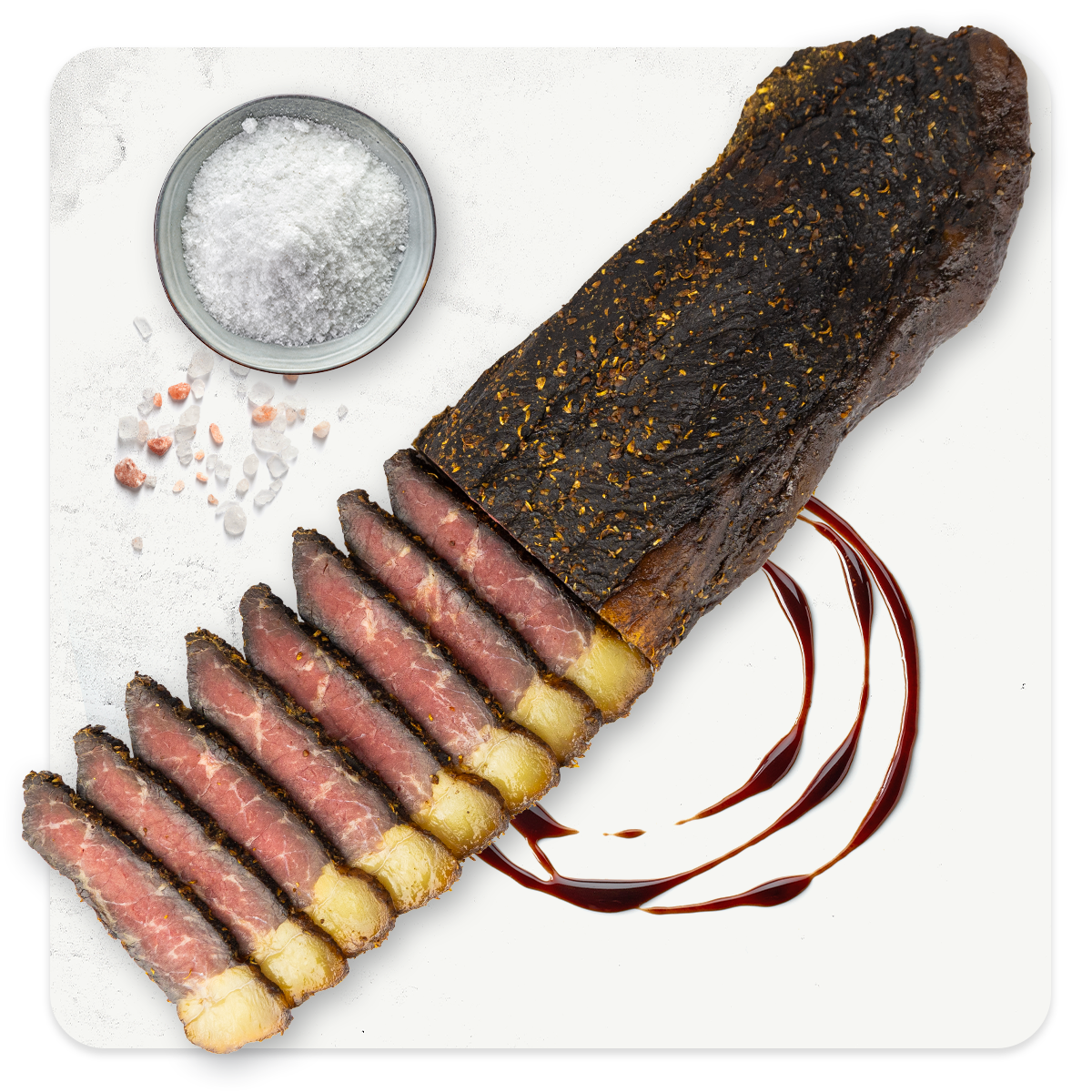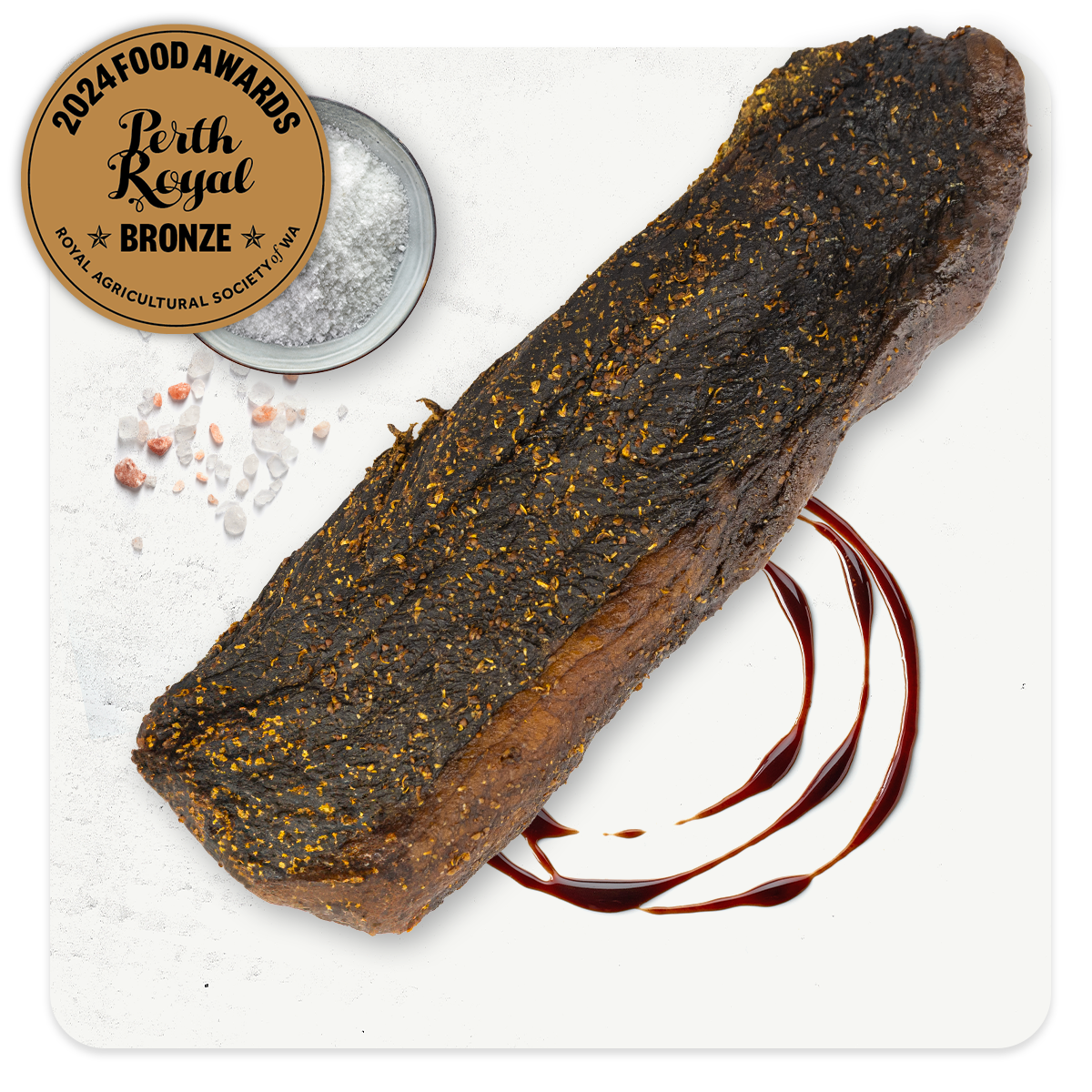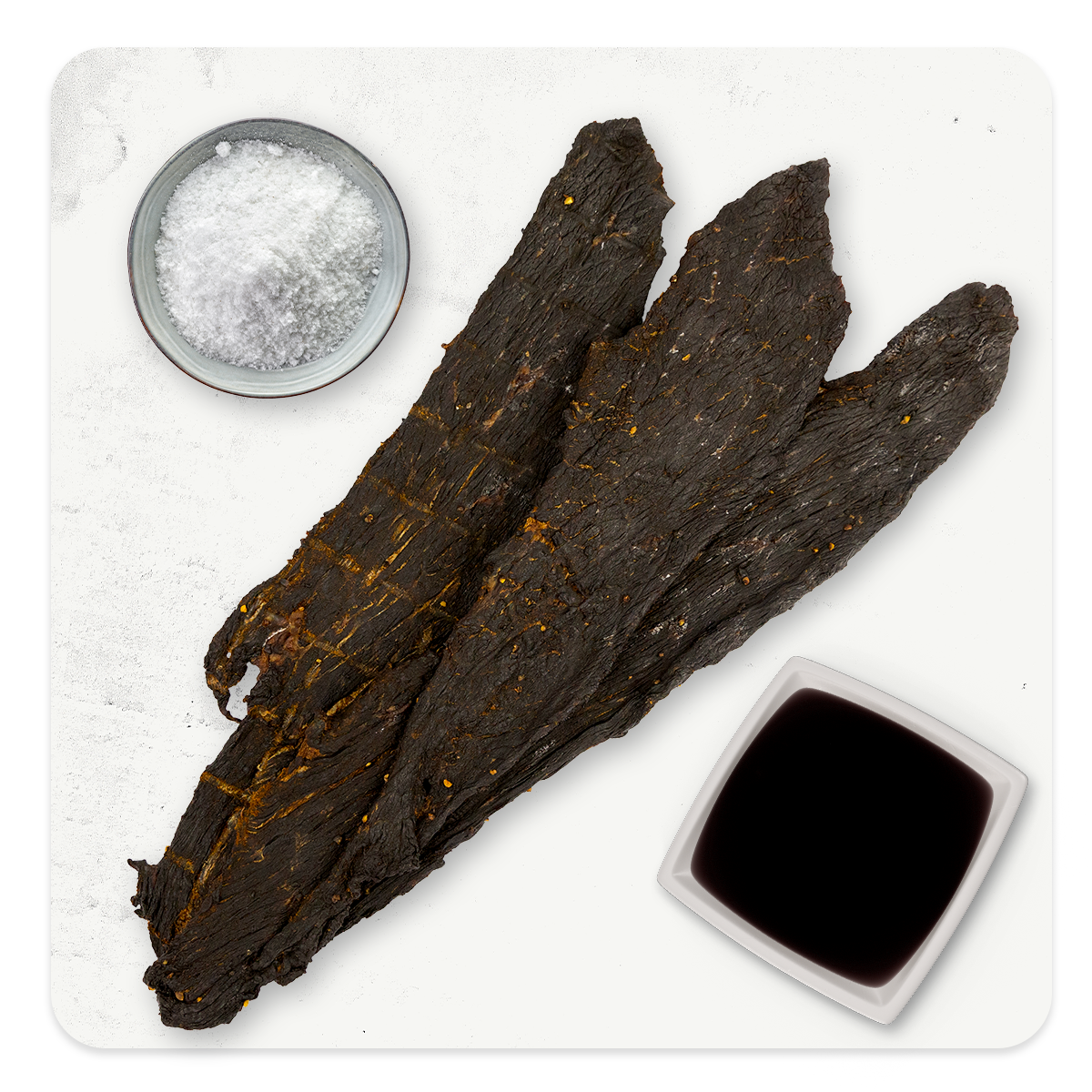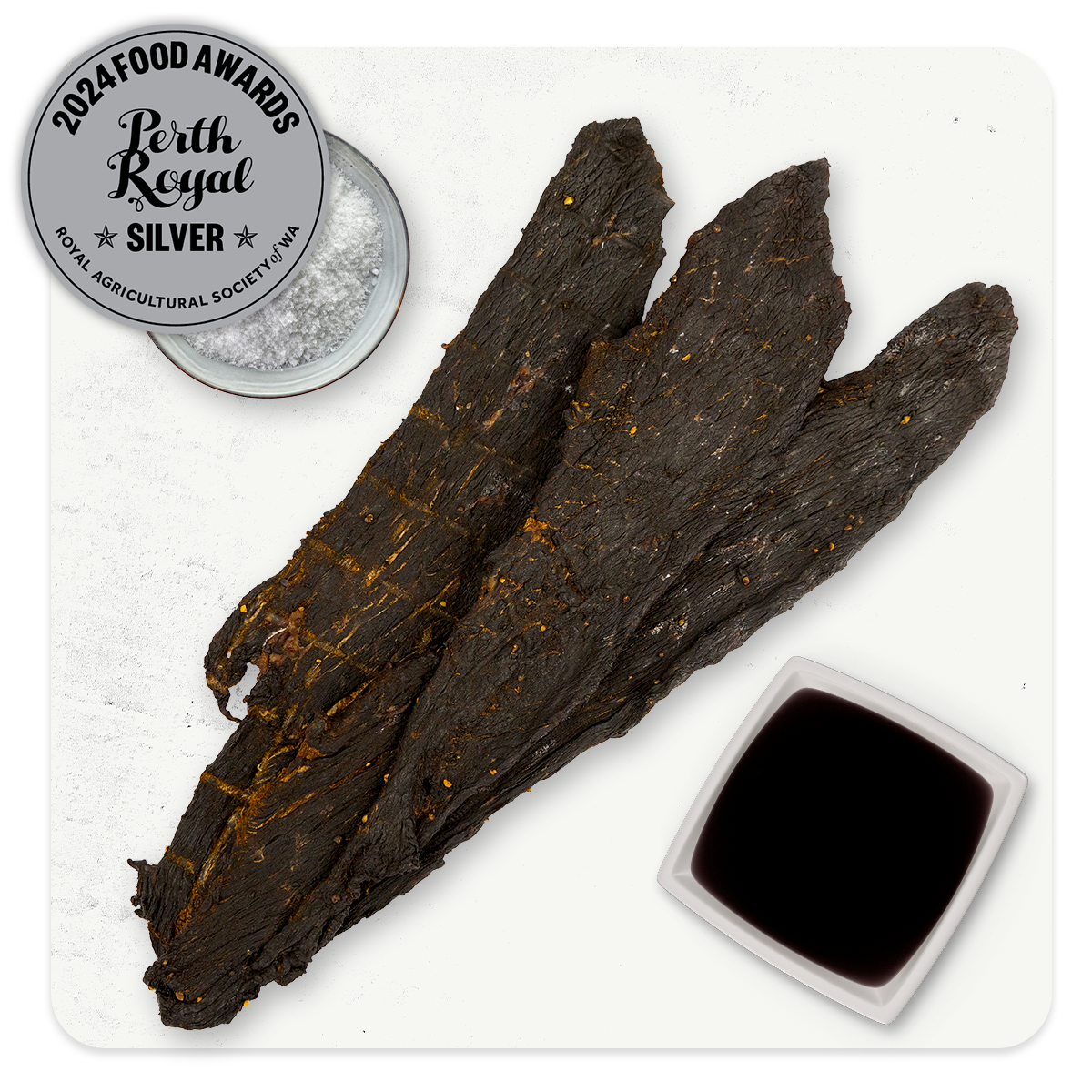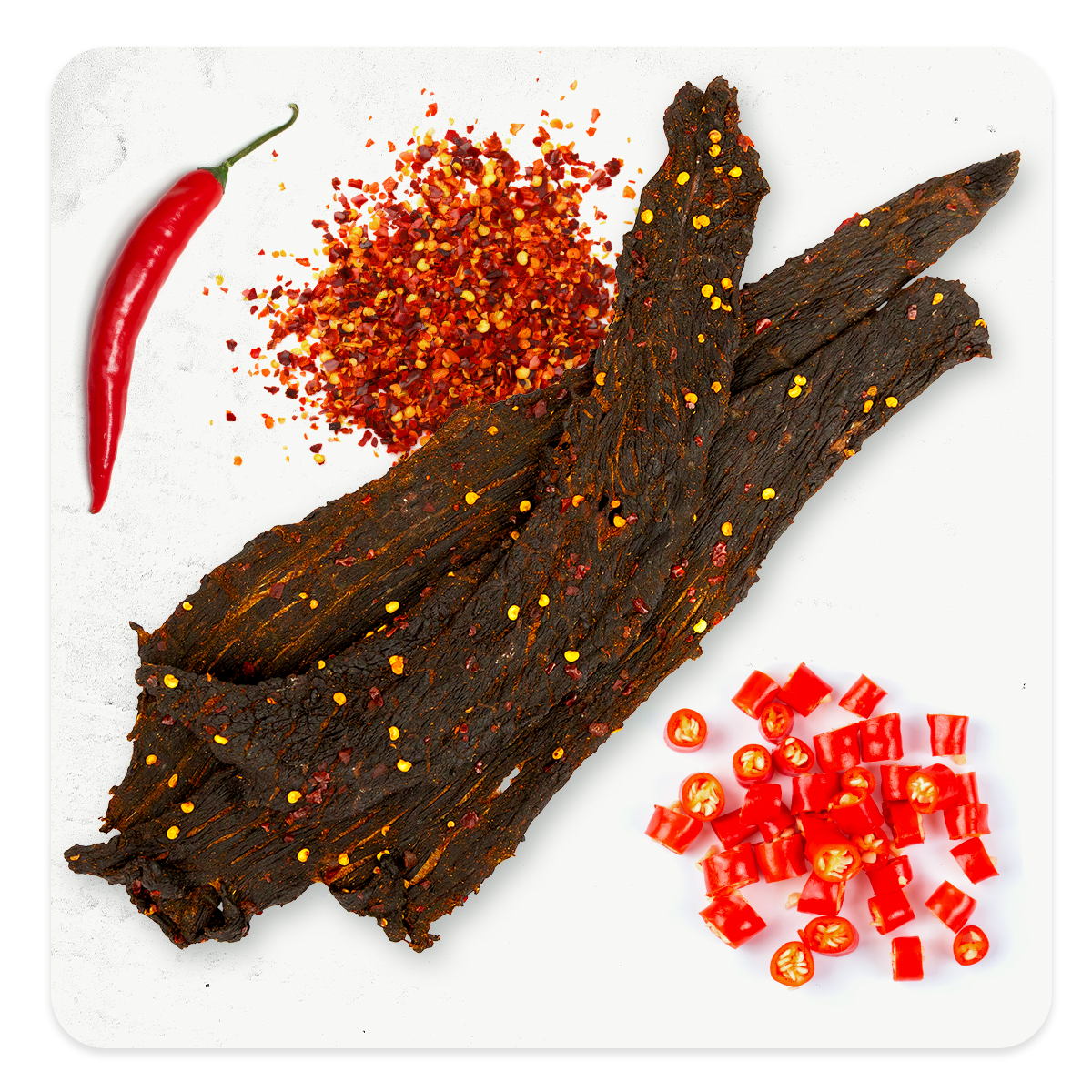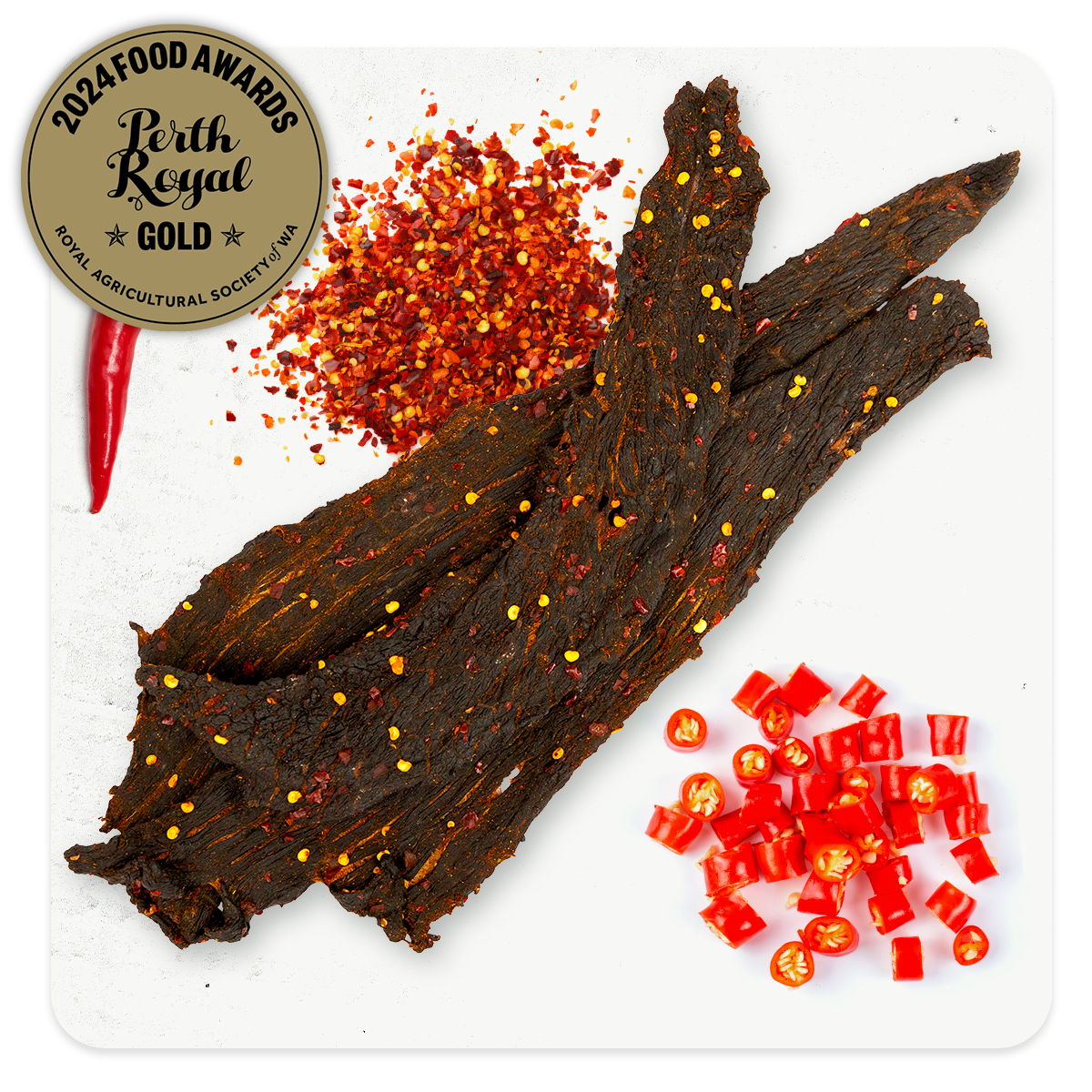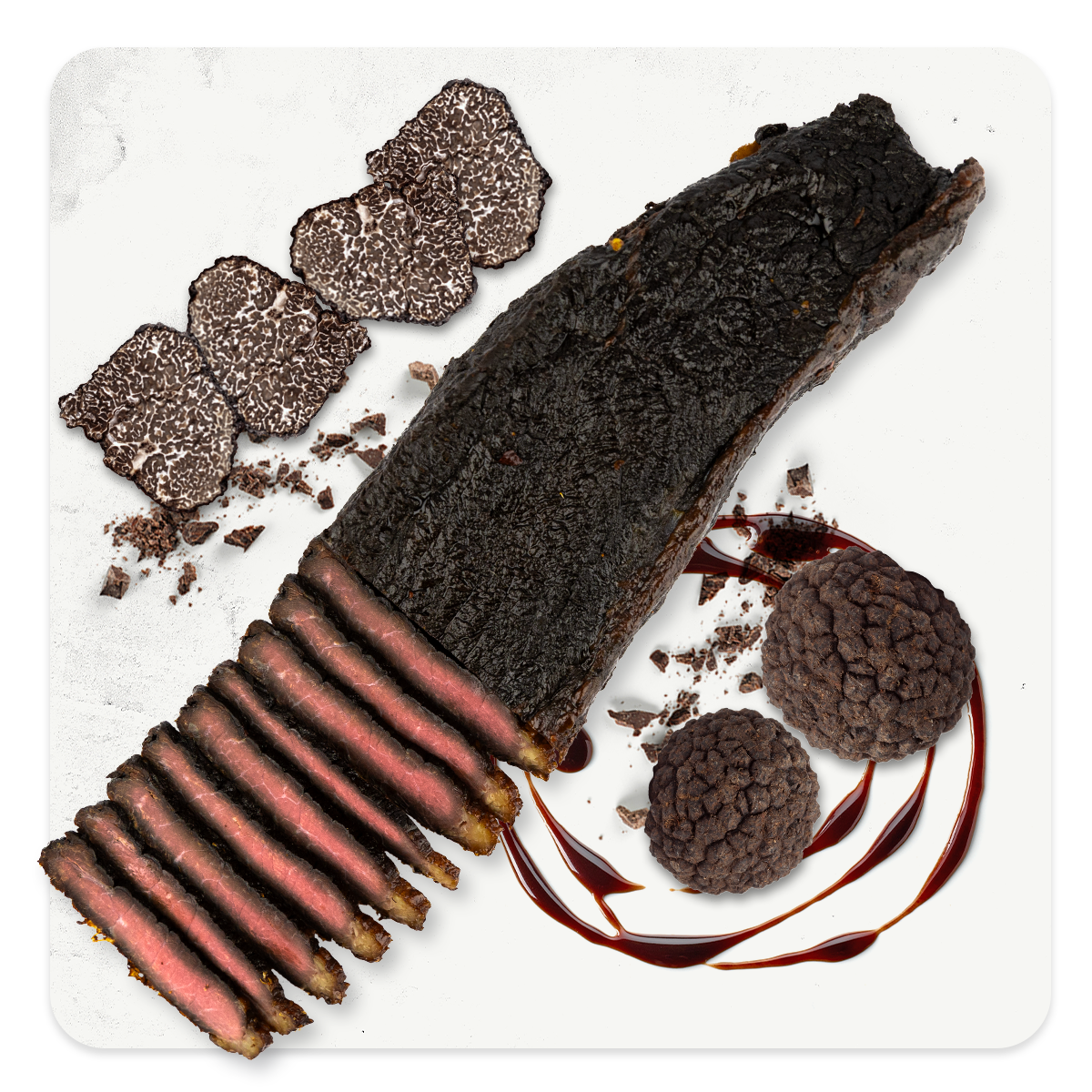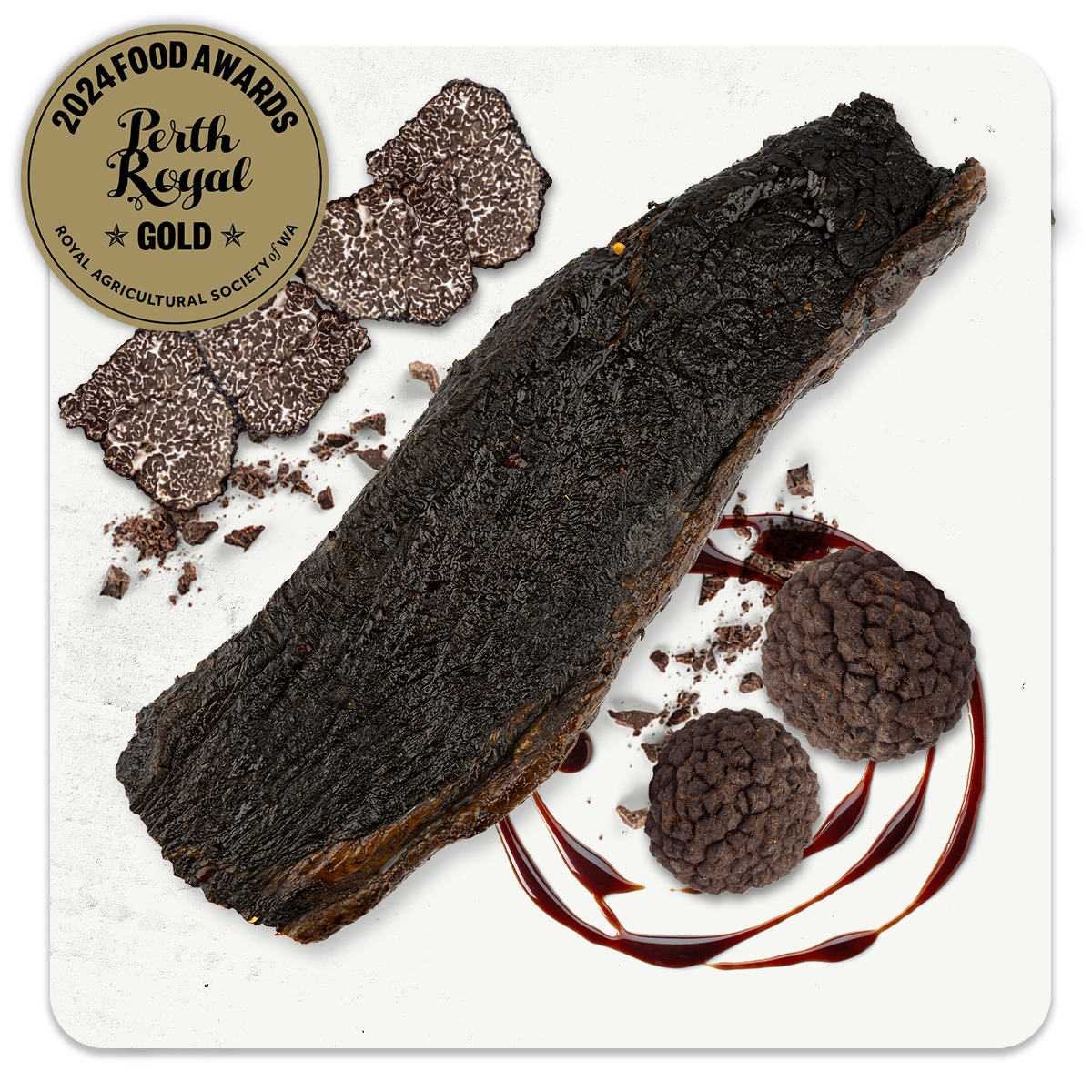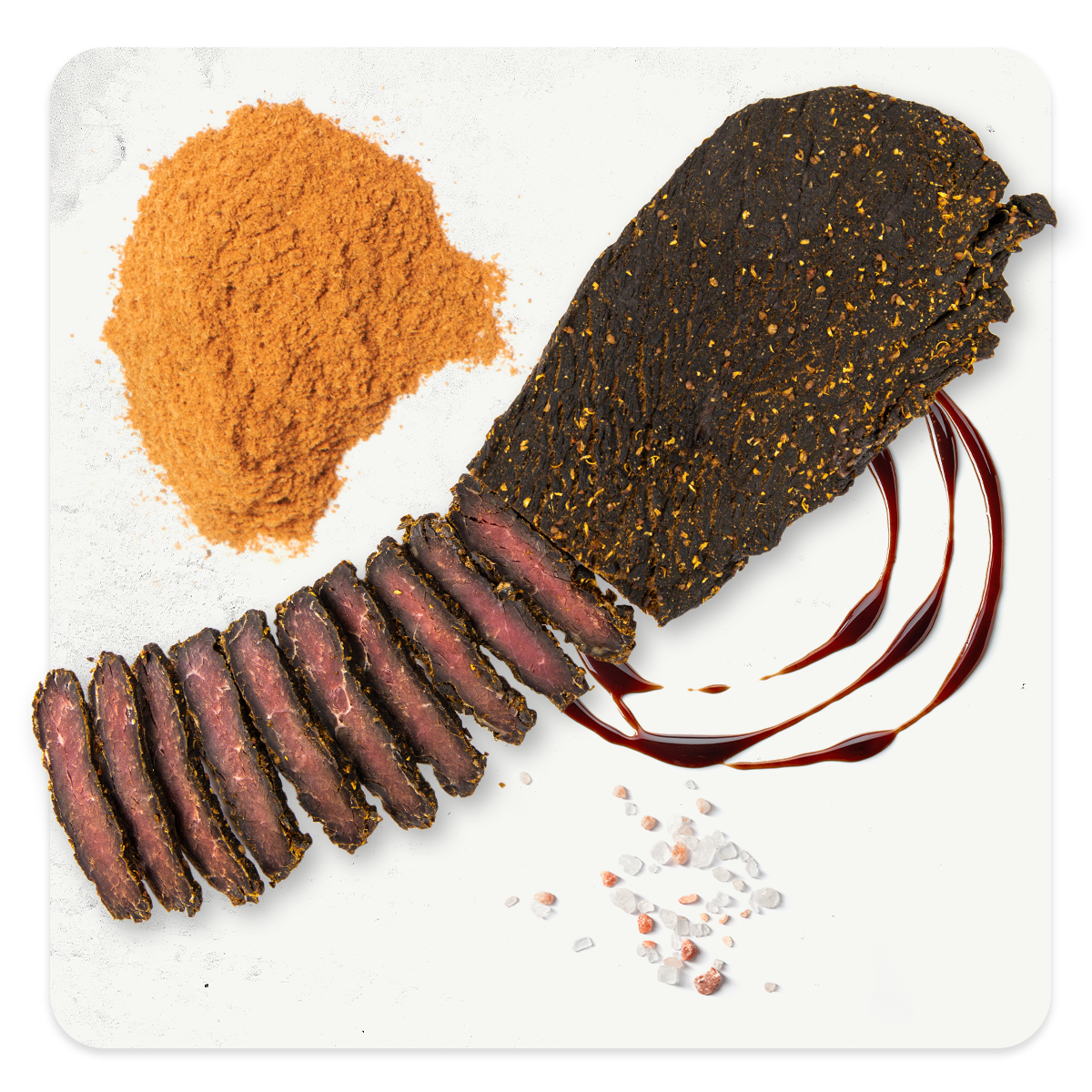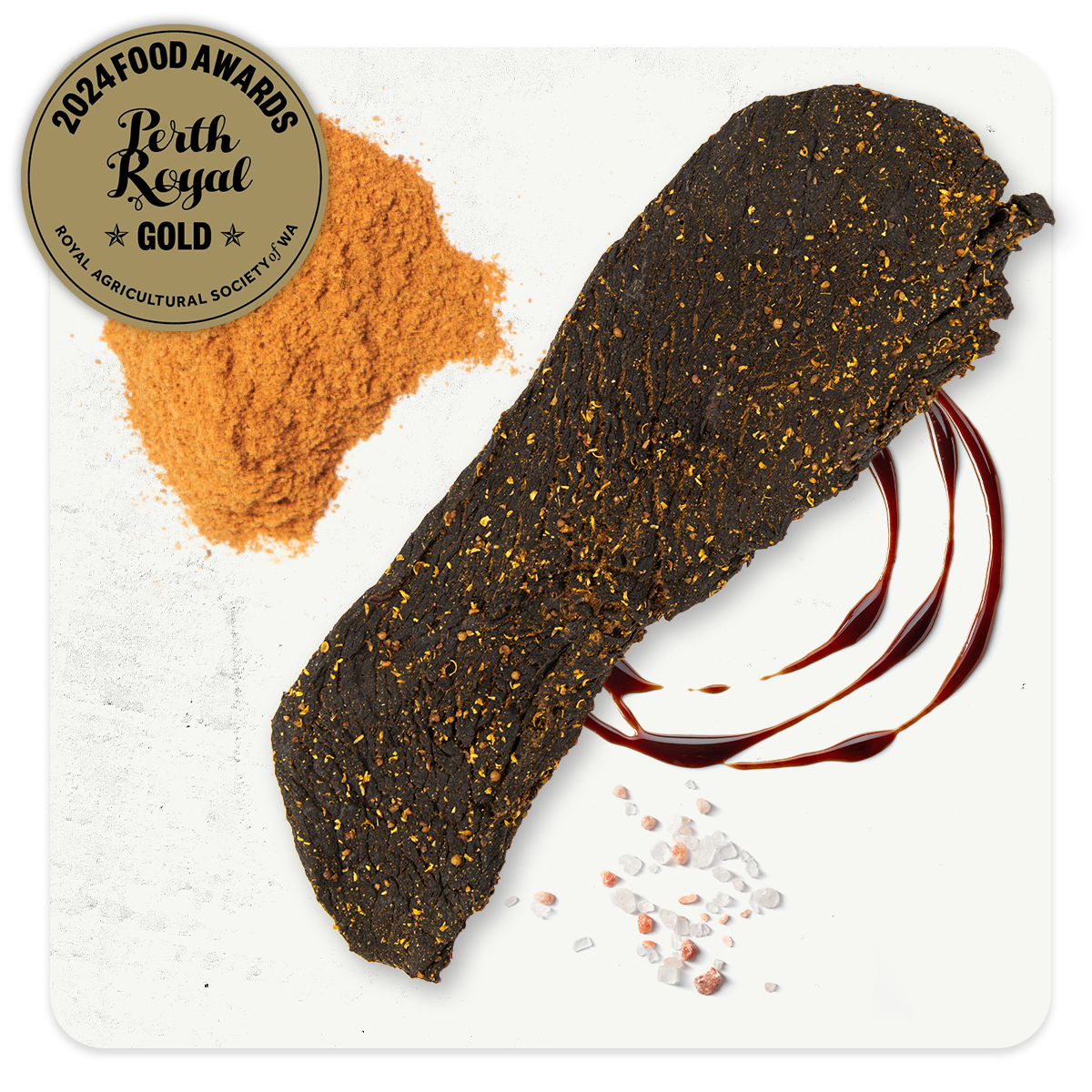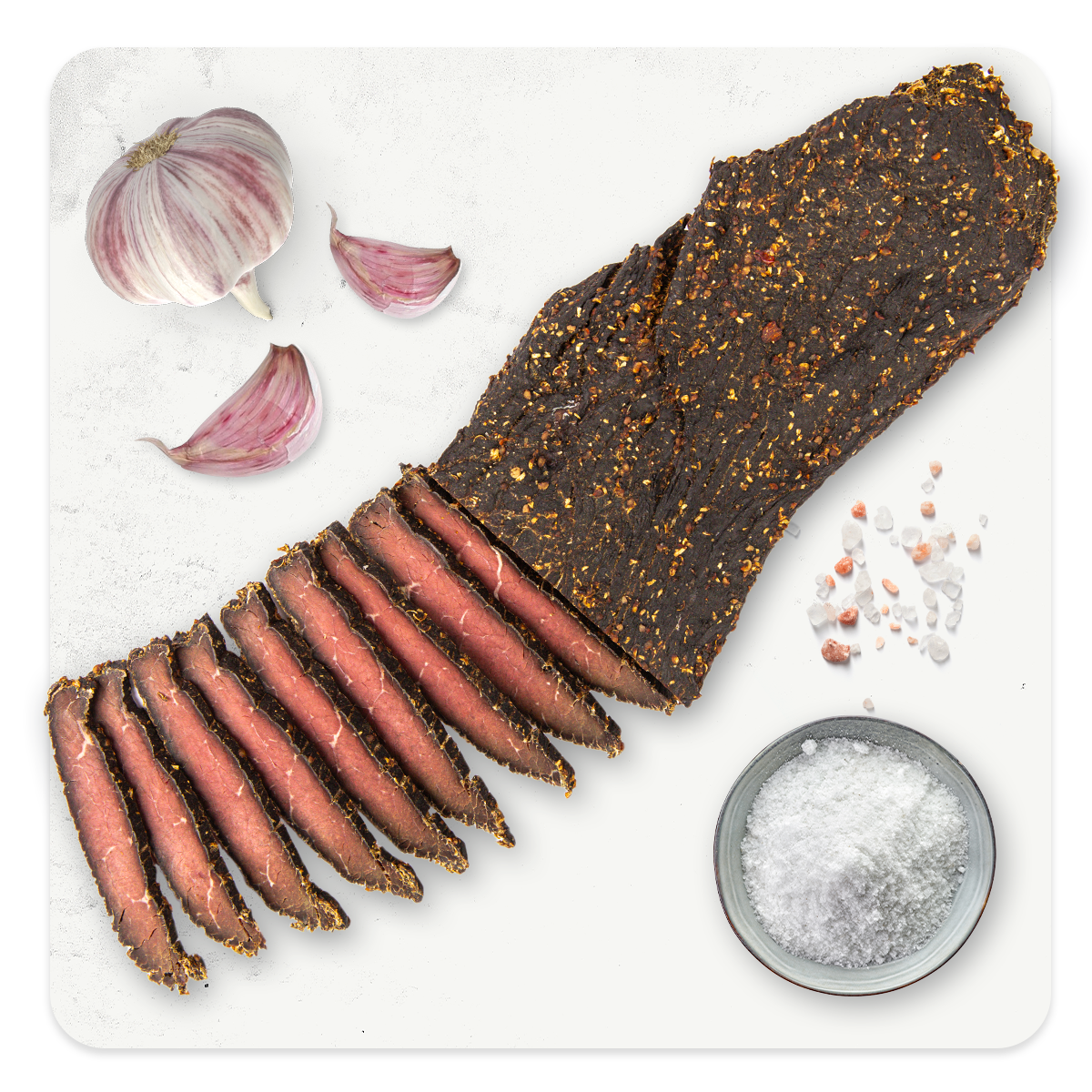News
Pros And Cons Of Homemade Jerky
DIY is all the rage now - and for good reason too. It's satisfying to step back and admire something you've just made. But you know what's also satisfying on a whole other level? A juicy mouthful of our smoky beef biltong. Or jerky. Or droewors. They're all flippin' delicious snacks to have after a DIY job. But if you have your mind set on making some homemade jerky, read about the risks and benefits before getting your hands dirty. You want to make sure you know what you're doing, or risk contaminating the meat and getting really sick! So keep scrolling down for some homemade jerky facts to help you weigh up the pros and cons of making your own homemade beef jerky. Savings: Is it cheaper to make your own jerky? Making homemade beef jerky allows you to choose the type of meats and spices that goes into the snack. This way, you can source cheaper cuts of meat and use flavourings you have lying around the kitchen (like brown sugar, soy sauce, garlic powder, and onion powder). If you've never attempted making jerky at home before, you might find a great jerky recipe online. However, it can be a hit-and-miss situation when you’re trying to perfect the flavour, texture, thickness, and moisture levels of your jerky. You might buy a lean cut that is too old or dry, or burn some sliced meat on the oven rack because you've cut it too thin. Also, you would have to keep a close eye on the temperature and the time your sliced meat is left to be cooked or smoked. So, while you might be able to save some dollars on the ingredients and cost of labour, you could end up with a botched final product that disappoints. Unless you're okay with trying to feed your pet a burnt piece of meat, opt for our air dried meats instead. Using our 100% Australian ingredients, we soak our meats in marinade for 24 hours to get that unforgettable flavour. So if you're having a go at attempting homemade jerky, try replicating the lingering taste of our beefy bites - we dare you! Food safety: Is it safe to make homemade jerky? Unless you own a swanky food dehydrator or smoking equipment, it can be quite dangerous to try making homemade jerky. This is because improper preparation or storage methods can contaminate the meat. Without the right equipment and cooking techniques, dehydrating raw meat can allow pathogenic bacteria that can cause infections and sickness to grow. Salmonella outbreaks have been linked back to jerky that was not cooked quite right. To practice good food safety, you should always clean your oven rack, oven door, and dehydrator trays thoroughly after handling raw meat slices. Pathogens survive in the meat when the temperature of your food dehydrator or oven is not high enough. Some jerky companies try to work around this issue with contamination by adding heaps of preservatives to try to delay and stop mould, yeast, bacteria, and yeast from growing. Here at The Jerky Co., we use trusted cooking techniques that have been passed down in our family for over 20 years, which eliminate the need for preservatives. That's right, The Jerky Co. meats are 100% free from added preservatives. Storing jerky: How long does homemade jerky last? You should treat your jerky like any deli meat and practice good food safety. To avoid your homemade jerky going to waste, try to make just enough for each person to eat in one serving. An important thing to remember is to store your leftover jerky in an airtight container in the freezer if you are not going to finish it all at once. Check out our guide for how to store beef jerky to make sure you’re getting maximum flavour and freshness. Also, specifically when making jerky, lean cuts last longer than fatty cuts, so try to get rid of any visible fat unless you are planning to eat it all in one or two sittings. Is homemade jerky better than store bought jerky? Jerky companies often add preservatives to their meats to keep them fresher for longer. After all, packaged dried meat has to travel far to get into anyone's eager bellies. But fair warning, one particularly popular additive can cause some serious problems: sodium nitrate. Nitrates are often added to processed meats like sausages, bacon, and ham to help prevent the growth and spreading of bacterial spores, while making the colour of the meat last longer. The danger of nitrates is that when eaten, they can become carcinogenic nitrosamines in the intestines, which is linked to colon cancer. So if you are making your own jerky, leave out the heavy additives and share any leftovers or store it safely. And if you just need a quick protein and flavour hit, opt for our additive-free, air-dried meats that make for some super satisfying snacks. Get yourself some meat If you're keen on trying your hand at making homemade jerky, go for it! And if you come up with a recipe that gives our tasty meat treats a run for their money... have a think about joining our team of craftspeople. You can even add our bbq rubs to your meats to get that real Jerky Co. flavour for practice. Because truly, we make some of the best beef jerky in town. So what do you say? If you would rather eat some premium beef jerky ASAP instead of waiting for it to cook, order yourself a pack (or five!) of our tasty treats today. Fresh, topside beef delivered straight to your doorstep, Australia-wide.
Learn moreMouth-Watering Charcuterie Board Ideas
Look up #cheeseboard or #charcuterie on any social media platform and you'll find yourself swimming in an endless sea of impressive charcuterie board ideas. But with so many different serving board options, it can get overwhelming trying to decide how to decorate your own board. After all, not everyone comes from a family of food bloggers! However, doing some research and careful planning will help you work towards designing the perfect charcuterie board for your dinner or party. Luckily, presentation comes a close second behind top-quality cured meats here at The Jerky Co. In short, a good charcuterie board has a winning variety of flavours and textures that are thoughtfully displayed on a large board. Sounds pretty achievable right? So crack those knuckles and keep on scrolling down for some simple ways to create the perfect meat and cheese board. Plus, these charcuterie board ideas are so good, you could be done in less time than it takes to rip through a pack of The Jerky Co.'s cured meats. What is a charcuterie board? The word charcuterie borrows from the French term for cooked meats. Traditionally, it refers to preserved pork but is now a popular name for a style of meat and cheese board. The perfect charcuterie board is a well-presented selection of tempting cured meats, hard and soft cheeses, dried fruit, nuts, crackers, and fresh fruit. Today, the charcuterie board is popular in the West as a staple of many parties or gatherings. After all, they require practically no cooking and are fun to assemble. All the meats on a charcuterie board are already pre-cooked, smoked, or cured so you can just focus on making things look great. And the best part? A good charcuterie board can be as minimal or as intricate as you like! Because really, it depends on how much time you have on your hands - and who you’re trying to impress *wink*. The perfect way to start building a crowd-pleasing board is to choose your favourite cured meats and then pair it with different types of finger foods. And it must be your lucky day because we've got the best beef jerky and beef biltong to help kick start all your juicy charcuterie board ideas. How to pair cured meats and cheeses for a charcuterie board While it’s the presentation of your charcuterie board that will win people over, there's an art to pairing cured meats and cheeses. A surefire way to find a great pairing is to work with opposites. Both meats and cheeses are fatty, salty, and rich in protein. You don’t want to overwhelm the board with too much of the same flavours and textures. So instead, complement the protein and fat of one food with a more tart and tangy (acidic) flavour in the other. Meats that are encased tend to be more acidic, while whole muscle meats are generally sweeter with a nutty taste. If in doubt, try to pair cheeses and cured meats that come from the same region. Here’s how it might look in action. If you have some savoury ham, pair it with a more acidic, hard cheese like Gouda. Sweeter or smoked ham should be paired with soft cheeses like Swiss. After you choose the perfect meat and cheese combos, just sprinkle some dried and fresh fruit, nuts, spreads, jams, and crunchy crackers around the serving board and you've got yourself the perfect charcuterie board. What kind of board can I use for a charcuterie board? You can get really creative with this part. If you don’t want to go all out and get a fancy serving board just for one occasion, simply grab some butcher’s paper and line the top of the kitchen counter. You can serve up a really big charcuterie “board” this way if you are having a lot of people over! A marble board, your average cutting board, a Lazy Susan, cool tea towels, or multiple smaller boards next to each other or on different tiers are also great ways to serve up your cured meats and cheese platters. It's all about me(ats) Today's charcuterie boards are all about the cured meats. All the other flavours and textures are there to complement these perfectly savoury meat treats. So without further ado, grab a large serving or cutting board and help yourself to these tasty yet simple charcuterie board ideas. Calabrese salami, droewors, manchego, gouda, green apples, dried figs, raspberries, Ritz crackers Beef biltong, smoked ham, prosciutto, feta, brie, grapes, olives in a little bowl, chicken pâté, water crackers Chorizo, beef jerky, brie, pistachios, dates, strawberries, cherries, green apples, carrot and celery sticks, tzatziki, wafer crackers Biltong, Parmigiano-Reggiano, blue cheese, walnuts, apricots, pears drizzled with honey, duck pâté, water crackers Jerky, Irish cheddar, candied or roasted nuts, apricots, raisins, red and green grapes, vegetable crackers Mint lamb biltong, goat cheese, cranberries, prunes, pomegranates, cherry tomatoes, rosemary crackers Let's get fancy Because cured meats are the highlight of any epic charcuterie board, you'll want to make sure you pick the perfect meats to impress your guests. So make sure you get your hands on our beef jerky, biltong, snap sticks, or droewors. Our famous family recipes and spice blends make The Jerky Co.'s 24-hour marinated meats the best in the biz. Try a bite and we bet you'll be back for more. So go ahead, impress your guests with a charcuterie board that looks nearly too good to eat. Whether you're having family over, bringing a dish to a party, or hosting an event, serving up a charcuterie board is a great way to offer something for every finger food-loving guest. And with a generous serving of The Jerky Co. meats, we're sure there won't be a single crumb left.
Learn moreHow to Store Beef Jerky - Keeping Your Favourite Snack Fresh (Infographic)
Name one thing better than kicking it back with some of our signature beef jerky on a Sunday afternoon - we'll wait. Think we’re biased? Then try a bite of our premium air-dried meat for yourself! Here at The Jerky Co., we'd chow on this beef jerky all day, every day if we had the chance! But we’ve promised our loyal customers that they get to share some of this meaty goodness too. We’re cool like that. *cue sunglass guy emoji* But seriously, once you’ve caught a whiff of our beef jerky, there’s no going back. So while we can’t guarantee that you won’t be gobbling up our marinated meats in a flash, we can offer some great advice on safely storing your jerky stash. When stored correctly, you can keep your beef jerky fresh and delish for longer. Frozen jerky is perfect for whipping out when you have a surprise guest over - or simply for snack emergencies! Keep scrolling down to learn about how to store beef jerky safely for maximum flavour and freshness. How to store beef jerky A question we always get when customers want to buy a couple bags' worth of our dried meat is "what is the shelf life of beef jerky?". Well, these are topside MSA meat strips that after all. So, make sure to treat them as you would with any other fresh deli meat with this food safety advice. Our suggestion is to keep meat products in an airtight container below 5°C in the fridge and never at room temperature. Pop it in an airtight container like a mason jar, along with a food-grade desiccant, for short term storage. But if you happen to have a vacuum sealer - even better! We can't stress enough the importance of sealing that meat in. Because when you store it correctly, your beef jerky will last up to 7 days from delivery - though we bet that you'll finish it well before then! And for best results past 7 days, any of our dried meat snacks should be stored in the freezer. Can you freeze beef jerky for long term storage? Of course! You just have to do it right. Store your dried meats in an unopened airtight container in the freezer and they will last you a long time. And just how long will beef jerky keep, you ask? It depends on a couple of things. On average, frozen beef jerky and snap sticks can last over 12 months, while biltong around 8 months. The shelf life of frozen meat strips will also vary depending on factors like the internal temperature and water activity in your fridge. The best way to practice good food safety is to make sure that the meat is securely sealed prior to storage. If you're purchasing our meat strips online, they already come in vacuum sealed bags to keep the moisture in, and the air out. So it's best to leave the bag unopened and frozen if you want to save some for much later. Is beef jerky safe to eat? Historically, cultures all over the world have been known to preserve meat strips safely by turning it into variations of jerky. Here at The Jerky Co., we practice top hygiene and food preparation methods that makes sure each piece of dried meat is safe (and delicious!) to eat. Our marinades of soy sauce and spices are made from family recipes that date back for over 20 years, so you know it's that good. All our meats are slowly air-dried to get the perfect level of chewiness, and to make that marinade *pop*. Homemade beef jerky, on the other hand, can accidentally create an environment ideal for bacterial growth if the dehydrator or drying process used is not up to food safety standards. So really, the best way to make sure you get a chewy mouthful of scrumptiously safe dried meats is to hit us up. Also, make sure to follow the advice you literally just read about how to store beef jerky, so you can enjoy your marinated meats for longer! Plus, our jerky already has a pretty great shelf life as it is made to travel safely on the journey from our kitchens to your front door! How to safely prepare frozen jerky If you want to get your fangs into that stash of frozen beef jerky, make sure to defrost it properly before chowing down. Just pop however much frozen jerky you think you'll eat the next day in the fridge overnight to safely defrost. Also, if you prepare a little more than you can finish in one sitting, share it with someone within 1-2 days! We would hate to see you waste any of that sweet, sweet meat. And remember, never refreeze any dried meat that has been defrosted. Stop scrolling, start snacking Now that you've got some tips and tricks on how to store beef jerky safely - snack wisely! While we do craft some of the best beef jerky in town, you should always snack on our tasty treats in moderation and as part of a healthy, balanced diet. So be responsible-ish and keep some of that tempting sweet bbq, exotic truffle, and chilli beef jerky for later! And while you're here, be sure to check out our darned delicious range of premium air-dried meats. Jerky, biltong, droewors, snap sticks - we've got the lot! We ship Australia-wide and right to your front door so you can get your jerky fix whenever you please.
Learn moreJerky Vs Chocolate - The Easter Snacks You Should Be Eating
With Easter just around the corner, there's a whole lot to get done! Whether you are having some friends over, throwing an Easter celebration with kids, or having a meal with family, there are tons of easy Easter treats to make that everyone will enjoy. While it's tempting to just throw a pack of Easter eggs or chocolate bunnies on the table and call it a day, why not keep the sugar intake to a minimum? If you know us, you know we'd choose some of our cured cuts over a sweet snack any day. So here's a wild idea - opt for savoury Easter snacks like beef jerky instead! Cut back on mindless chocolate-eating this Easter and opt to enjoy some tantalising 24-hour marinated, air-dried beef from The Jerky Co. Plus, there are tons of ways you can get creative with jerky in the kitchen. We have a whole recipe section dedicated to that! Keep scrolling to learn why you should go easy on the sugary Easter snacks, and get inspired by some of our favourite ways to serve jerky at your next Easter dinner. Why you should cut back on sweet treats this Easter season Sure, having chocolate eggs on Easter is as tasty as it is tempting, but there's a number of reasons why it's so hard to quit snacking on this processed sweet treat. The large amounts of added sugar in milk chocolate gives you an instant dopamine kick - one that makes you crave it again and again! Sugar is one of the main culprits responsible for making you feel bloated, put on unwanted weight, feel anxious, have increased blood pressure, and much more. Although the initial spike in blood glucose levels can trick your body into thinking you feel great, the high only lasts for a short while before blood glucose levels crash and bring on the negative bodily symptoms. Indulge now and feel the consequences in your gut later. Easter baskets tend to be filled with festive snacks like white chocolate Easter eggs, caramel Easter bunnies, jelly beans, and almost anything else made out of chocolate. These Easter snacks may be a tempting sweet treat, but they have an exceptionally high sugar content that contributes to that familiar post-meal sluggishness. While it's okay to snack on sweet treats from time to time, the Easter season tends to encourage us to overindulge on heavily processed, sugar-loaded snacks. Unless you are eating only dark chocolate that is 70% cocoa or higher, you're feeding your body more sugar and calories than it needs. So, to avoid the sugar crash that can lead to more sugar cravings and mood swings, why not opt for healthier Easter snacks instead? As we said, beef jerky can be a surprisingly tasty alternative that comes with health benefits. Surprising health benefits of red meat If you find yourself asking "is beef jerky healthy?", then try our 24-hour marinated, air-dried beef jerky to see for yourself! We think that our protein-packed snack is some of the best beef jerky in town, as we use only topside MSA grade red meat. Also, our mouth-watering jerky is made using a treasured family recipe passed down for 20 years, so you can be sure you are getting a high-quality treat. And did you know that red meat is loaded with nutrients? Besides being an excellent source of animal-based iron that your body can easily absorb, this powerful protein is abundant in key micronutrients such as vitamin B12, zinc, calcium, and omega 3 fatty acids. While you might be tempted to snack on it all day long, it's best to chomp in moderation and as part of a balanced diet. As the Heart Foundation recommends eating one 350g serve of red meat per week, what better way to enjoy your weekly serving than with a delicious bite of beef jerky? Treat your body and taste buds to The Jerky Co goodness - we promise you'll be back for more after Easter celebrations have ended! How to prepare beef jerky at home There are so many different ways to include jerky in your Easter dinners and snacks. Whether you choose to use it in entire meals, bite-sized Easter snacks, appetisers, or as drink pairings, jerky goes well with a variety of flavours and textures. Here's what we're doing this Easter at The Jerky Co: Easter brunch: You can't go wrong with a well-presented charcuterie board! Be generous with the amount of cured cuts and sprinkle the board with a variety of nuts, dried fruit, cheeses, and even pickled nibbles. You can also serve this as a starter. Easter parties: Mojitos anybody? Whip out that cocktail shaker and impress your guests with a classic mojito. Pair this refreshing drink with some jerky canapés for a real good time. Easter dinner: Serve up some warm Mediterranean style soup and top it with slices of fresh jerky to impress your guests. Eat well, feel better Opting for protein-rich snacks like beef jerky will help you stay fuller for longer while curbing any cravings for sugary Easter snacks. Do yourself a favour and check out our range of creative yet easy-to-follow recipes that include jerky. Make sure to follow us on our socials too for the latest ideas on spicing up your meals with cured cuts. And if you prefer a juicier chunk of air-dried steak, we've got just the biltong for you. Be sure to check out our droewors and snap sticks while you're here - they're a real crowd-pleaser, that's for sure. While we’re not suggesting that you give up chocolate altogether, it’s a good idea to be more mindful about what you are fuelling your body with over the Easter holiday.
Learn moreNutritional Benefits Of Eating Red Meat - Infographic
Did you know that red meat and other animal-based foods are excellent sources of not only protein and iron, but also key micronutrients such as calcium, zinc, omega 3 fatty acids, and vitamin B12? Without getting your daily intake of certain key micronutrients that are abundant in animal-based foods, you might end up with a nutrient deficiency! Let’s dive into how each nutrient benefits to your body.
Learn moreBenefits of Eating Red Meat
Yes, we know that a juicy piece of steak is delicious. And yes, we know that too much of a good thing can be… too much. But while we don’t advocate eating just red meat for breakfast, lunch, and dinner, we do think that including red meat as part of a balanced diet and active lifestyle can be a healthy (and tasty) choice. In fact, if you’re going to snack at all, opting for some flavoursome air dried meat snacks like our 24 hour-marinated jerky and biltong are a way healthier choice than reaching for a bag of greasy chips or sugary lollies. Keep scrolling to find out more about the surprising health benefits of eating red meat. Nutritional Benefits of Eating Red Meat Did you know that red meat and other animal-based foods are excellent sources of not only protein and iron, but also key micronutrients such as calcium, zinc, omega 3 fatty acids, and vitamin B12? Without consuming certain key micronutrients that are abundant in animal-based foods, you might find yourself having a nutrient deficiency and having to supplement. Let’s talk about how each nutrient benefits your body. Protein: This macronutrient not only powers your body, but it also helps you feel fuller for longer, builds and repairs muscle, boosts your metabolism, helps fast track your weight loss, as well as protects your body from getting sick. One of the benefits of eating red meat is that it can easily help you meet your personal protein requirements. Iron: Red meat is one of the best sources of haem iron that your body can easily absorb. This mineral is essential for helping your blood efficiently transport oxygen from the lungs to the rest of the body. When your body receives enough iron through the food you eat, you have more energy and an improved ability to concentrate. Iron also aids in regulating the movements of your GI tract, your body temperature, as well as keeping your body’s immune system in check. Calcium: This is another key mineral that helps to prevent you from developing bone degradation issues like osteoporosis and rickets. If you don’t include enough calcium in your diet, your body may begin to draw this mineral from your bones. When this happens, not only do your bones get weaker, you may also feel more irritable, anxious, and down than usual. Zinc:Another one of the benefits of eating red meat is its high zinc content. Zinc is a micronutrient that helps your immune system fight off bacteria and illness. It also helps your body make protein and DNA, heal wounds, and regulate your senses of taste and smell. Omega 3 Fatty Acids: While fatty fish, nuts, and plant oils are the best sources of omega 3 fatty acids, you can also find them in red meat. These three acids (ALA, EPA, DHA) benefit not just your heart health, but also help regulate your cholesterol levels. blood pressure, and mood. Vitamin B12: One of the other nutritional benefits of eating red meat is the amount of vitamin B12 present. This vitamin gives your body a boost in energy while preventing you from developing a type of anemia. It also helps regulate your nervous system. Health Benefits of Eating Red Meat For a healthy heart, the Heart Foundation recommends eating lean meat about 1 to 3 times a week. Read more about that in their 2019 published statement “Meat & Heart Healthy Eating” if you’re keen. Current research also advises that each person should eat no more than 350 grams of unprocessed red meat in a week. However, this advice is not a one-size-fits-all solution for everyone. In fact, the Evidence Review published in the same statement above found that including up to 1 serve of unprocessed red meat a day can be a reasonable choice depending on your overall diet and lifestyle. Just as each person has different energy requirements and health goals based on factors such as your lifestyle, diet, gender, and age, so does the amount of red meat you should consume vary. Also, did you know that Australian red meat has a higher omega-3 polyunsaturated fatty acid content than U.S. meat? This is mostly because of the different animal diets. Australian red meat tends to come from pasture-fed animals, while animals in the U.S. tend to be grain-fed. Thanks to the abundance of grazing pastures here down under, not only does our grass-fed beef have stronger flavours and textures, but they are also much leaner than if they were grain-fed. Munch in Moderation Snacking on some jerky or beef biltong is one of the best ways to enjoy your weekly intake of red meat. If you’re wondering “how is beef jerky made?”, head on over to our blog where we talk more about The Jerky Co’s methods of air drying marinated meat using a recipe that has been passed down for generations. We use only high-quality topside MSA beef that tastes as delicious as it is good for the Aussie meat and livestock industry. While it can be tempting to serve up a steak for every other dinner and snack on jerky every chance you get, red meat is best consumed in moderation and as part of a healthy, balanced diet to help meet your personal nutritional and energy needs. That being said, we do have tons of meal and snack ideas that include our 24 hour-marinated, air dried, topside MSA beef, so you can look forward to savouring your next serving of red meat.
Learn moreIs Beef Jerky Healthy?
Jerky is no doubt a delicious snack to grab as you’re running out the door or as a post-workout protein hit. However, there are quite a few concerns some people have about consuming cured meats. People often think of beef jerky as another “junk food” that has no nutritional benefits. But guess what? We believe jerky brings more to the table than just a burst of flavour. So if you’re wondering “is beef jerky healthy?”, keep scrolling to learn why you don’t really have to feel guilty about snacking on this good stuff. What makes a food “healthy”? What kind of food do you think of when you see the word “healthy”? Fruits? Vegetables? Most people will agree that a healthy diet consists of whole, unprocessed foods which provide your body with essential nutrients that it needs to keep your health, mood, and energy levels in check. So it’s really all about balance: making sure that your body gets enough nutrition from a variety of whole food sources. And nutritious snacks are part of the equation. That’s why we think that asking “is beef jerky healthy?” is too simple a question. Because while jerky is a snack food, it can be a great source of some key nutrients. Does beef jerky have health benefits? When it comes to beef jerky, some people might think that it’s all fat and salt. But did you know that depending on the cut and source of jerky, they can be really low in fat? Plus, they are really low in carbs and can be a great source of protein, zinc, iron, and other essential minerals. Check out the Nutrition Information Panel labels on the back of our cured meat snack packs or head to our About Us page to see for yourself! Okay, but it’s still full of salt. Isn’t salt bad? While too much sodium can be harmful to your health and body, you can also become sodium deficient if you cut it out completely. Again, it’s about balancing what you eat with what your body needs. Unless you’re eating jerky for every meal, every day, tossing a handful of this good stuff into your gym bag or kid’s lunch box can have more benefits than downsides. Being a rich source of protein, zinc, and iron, a bit of jerky can keep you going for longer while giving your body a nutrient boost. Cultures all over the world and throughout history have used salt to keep meat from going bad and breeding bacteria. As jerky is a type of preserved meat, it can be quite high in sodium. But like most things, jerky is best enjoyed in moderation and as part of a varied diet - even though it’s tempting to just keep chomping away on them! Should you snack on jerky? If you already have a diet containing the right amount of protein, carbohydrates, fat, water, vitamins, and minerals that your body needs - great work! But we know that in our often busy modern lifestyles today, it can be tricky to eat and snack right. So that’s why we think that cured meats can be a great way to give you a protein and iron boost on the go, helping to keep you staying focused and fuller for longer, while curbing your appetite for a bag of chips or lollies. When should you eat jerky? Jerky, as well as our other choices of cured cuts, is such a versatile snack that just works with many types of lifestyles and schedules. If you’re a busy parent, grab some jerky to toss into your kids’ lunchboxes as one of their snack options. If you’re looking for a protein and iron boost to complement your workout, toss a pack of jerky into your bag on the way out. Jerky is also a great snack idea whether you’re going on a road trip, to the beach, or to the movies. We’ve got a deliciously great range of cured meats to suit different lifestyles, make sure to check them out! Pick your protein We use only topside MSA beef to create our premium, air dried cuts. Good for your tastebuds and the Aussie beef industry. Win-win! And if you find yourself tossing up between biltong vs jerky, it really comes down to what food textures you prefer and what your body needs as these are both great iron and protein sources. So go on, grab yourself a handful of our sweet bbq biltong, droewors, or chilli beef jerky as you head out for a run. But just a word of caution: you might find yourself running straight to one of our stores for more!
Learn moreWhy MSA Grade Beef Matters
We love meat. And we want to make sure you can taste our passion for a quality chunk of meat in every bite. That’s why we choose only topside MSA beef to create every delicious piece of air dried meat that you know and love. But it's not just about the quality and flavours - choosing MSA beef means directly contributing to improving the Australian beef industry. Below, we’ve summed up what you need to know about MSA beef into bite-sized chunks. What is MSA? Meat Standards Australia (MSA) is an industry description system that helps the consumer by taking the guesswork out of buying beef. They do this by labelling each cut with an eating quality grade and recommended cooking method. Before hitting supermarket shelves, MSA graded meats must meet the standards set by consumers at one of three quality levels: MSA 3, MSA 4 or MSA 5. Basically, MSA beef helps make the quality and price of beef reliable and consistent. Hold up - who’s calling the shots? Meat & Livestock Australia (MLA) have put in place the MSA grading system for beef that puts the customer’s needs first, values accountability through transparency, and outcomes that have a positive impact on the Australian red meat and livestock industry. What is the impact of MSA grading? The MSA labels advise consumers of the correct cooking method for every piece of beef to assure a standard eating quality result. At the retail level, these labels can help determine the price of meats, which replaces the complex and misleading system of cut names and quality descriptions that may be unregulated. Who determines the MSA grade? The MSA grade is decided by you, the consumer. All MSA beef is graded on the basis of the consumer test score predicted for a particular beef muscle cooked by the nominated method. It’s a big topic but you can find out more about it on the MLA website or MSA Tips & Tools: How MSA grades are determined. How does MSA grading work? The MSA grades are established by taking into account the effects of all factors that can affect the final eating quality. These grades are set from the analysis of consumer test results. To date, a huge database of over 86,000 consumers across 8 countries have participated in MSA consumer testing providing scores on the eating quality of over 603,000 beef samples. That’s a whole lotta opinion on beef to cover! The MSA-trained graders also collect information from cattle suppliers, abattoirs, and chillers. This info is then put into a computer that takes into account each of these factors and estimates their effect on eating quality. The MSA grade score is then produced, which takes into account tenderness, juiciness, flavour, and overall liking scores. What makes MSA grading reliable? MSA accredited graders grade on behalf of the industry. Graders are frequently monitored, assessed, and analysed to maintain the accuracy of their work. Every bit of unsatisfied consumer feedback is heard and traced back to the source. Who gets to use the MSA grading system? Anyone that chooses to participate in the MSA system is licensed and on the basis of providing detailed audits and total product integrity. MSA training is available to all sectors of the beef supply chain to ensure participants have a solid understanding of the MSA system fundamentals. Help yourself to another bite Now that you’ve read up on these cool facts, you’re probably wondering “how is beef jerky made?” or already reaching for another handful of chewy, protein-packed goodness. Either way, make sure to check out our delicious range of handcrafted air-dried meats. The Jerky Co uses the finest grade of MSA beef in our jerky, biltong, and snack sticks so you get the best culinary experience in every bite. And while you help yourself to another piece, just tell your mates you’re also helping out the Aussie beef industry!
Learn moreIs Protein After a Workout Necessary? - Here's What You Should Eat
No matter where you are in your fitness journey, or what your fitness goal is, protein is your friend.
Learn more











